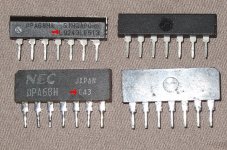Checked it. No cold soldering, but I resoldered. Looks better now 
I'm using Beyerdynamic DT1990 Pro for home an Shure SE-846 for mobil.
Recently I used Hifiman Edition X (First version), but sold them.
I'm planning to buy a new one this year... maybe a Hifiman HE1000... we will see.
I'm using Beyerdynamic DT1990 Pro for home an Shure SE-846 for mobil.
Recently I used Hifiman Edition X (First version), but sold them.
I'm planning to buy a new one this year... maybe a Hifiman HE1000... we will see.
DT1990 Pro is very nice. Has great detail and bass. A touch colder in mid tone than Sennheiser HD660S but more resolving and extends lower. HE1000 is cool but in a really expensive category. Must listen very carefully to all the main contenders in its price range before buying. This amp you build now will be different to the one you now got for sure.
These guys maybe demo STAX in Germany? https://www.auditorium.de/search?sSearch=stax
DCG-3 and DCSTB soldering was done the day over. Still have to wait for transformers and heatsink. But I found a transformator with 2x 19VAC in one of my electronic boxes 
I just tested the DCSTB (each side seperat) and have following voltage values without any load:
Side A
+ 17.49 V
- 17.46 V
Side B
+ 17.30 V
- 17.24 V
I'm thinking of finetuning. What do you think about finetuning ? Is it worth to match the voltages to max. difference of 10-30mV
Greetings
Arnd
I just tested the DCSTB (each side seperat) and have following voltage values without any load:
Side A
+ 17.49 V
- 17.46 V
Side B
+ 17.30 V
- 17.24 V
I'm thinking of finetuning. What do you think about finetuning ? Is it worth to match the voltages to max. difference of 10-30mV
Greetings
Arnd
No worth. This is single ended with forced bias current from a source on the negative rail side. When the positive rail side is little different or exactly the same it makes no difference to the bias and offset. Your voltages are extremely near within each side for random Led bars references by the way.
Hi all, this thread is about a JFET & MOSFET preamp I am cooking for sometime now. Its two stage single ended Class A circuit.
It was developed on the bench involving much experimentation with topology and a range of active parts. Simulations came second.
Some speakers are insensitive, some amps also, or a source is relatively low output like a phono stage. So a line preamp with gain is good to have.
Its named DCG3 because it has DC servo and three MOSFETS. Its standard gain setting is also times three.
The main schematic is attached* Click for circuit description
Some THD plots when driving 1.5kOhm line input and various headphones are also attached.
*(12 Oct 2016 updated and build guide/bom pdf added)
erratum: C6,C7 should read 4x in the BOM. J3 in preamp's schematic is named Q5 on the actual board.
About J3/Q5 possible tolerances read post#452
what is the use of VR1?
Thanks for your reply, so I can leave it as it is.
I just ordered the chassis and a ladder volume control (a chinese one which will be pimped with reasonable resistors).
I had luck to get the same chassis as my dac, so the units will look familar.
Nominal resistance is one thing. That's what the source sees. But ask them for one with no more than 5K output resistance. Else the preamp will slow down its rise time to more than its meant to be.
what is the use of VR1?
Offset minimizing before putting the servo chip in the socket
Nominal resistance is one thing. That's what the source sees. But ask them for one with no more than 5K output resistance. Else the preamp will slow down its rise time to more than its meant to be.
Thanks for the hint. Probably the chines ladders use a circuit as described here:
Logarithmic Attenuator Calculator
With changing the wiring of the chinese ladder at the first relais it must be possible to get a constant output resistance.
You can even fine tune the ladder's Zout to your liking regarding its audible effect on the preamp's bandwidth and rise time.
When different PSU, special non conventional series pot, changes in electrolytics values, etc. are tried, the preamp may change behavior from subtly to much out of its standard build character. This is a double edged sword. Could either help or hurt. The expert DIYer can evaluate and control parameters to only benefit though.
Also the uPA NEC monolithic JFET flat packs must be measured genuine for IDSS and curves if their sourcing is doubtful. Main clue: There is a number printed on them starting with a letter. That's their IDSS classification letter. If they fall out of their intended range they are suspicious. Don't use them.
When different PSU, special non conventional series pot, changes in electrolytics values, etc. are tried, the preamp may change behavior from subtly to much out of its standard build character. This is a double edged sword. Could either help or hurt. The expert DIYer can evaluate and control parameters to only benefit though.
Also the uPA NEC monolithic JFET flat packs must be measured genuine for IDSS and curves if their sourcing is doubtful. Main clue: There is a number printed on them starting with a letter. That's their IDSS classification letter. If they fall out of their intended range they are suspicious. Don't use them.
Attachments
- Home
- Source & Line
- Analog Line Level
- Salas DCG3 preamp (line & headphone)


